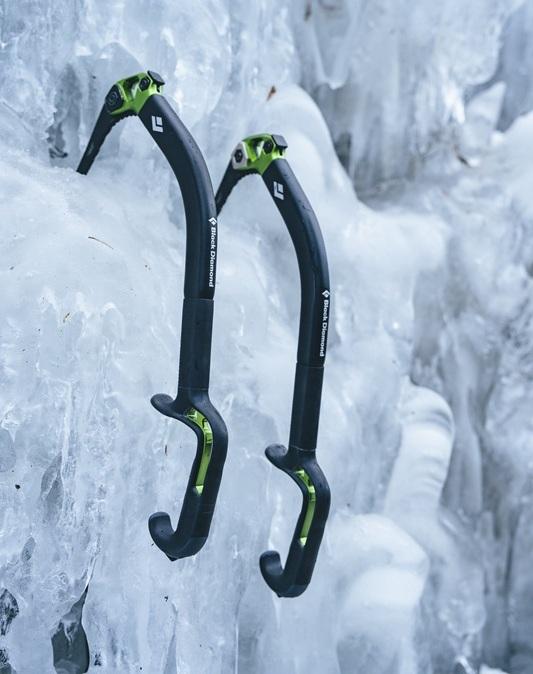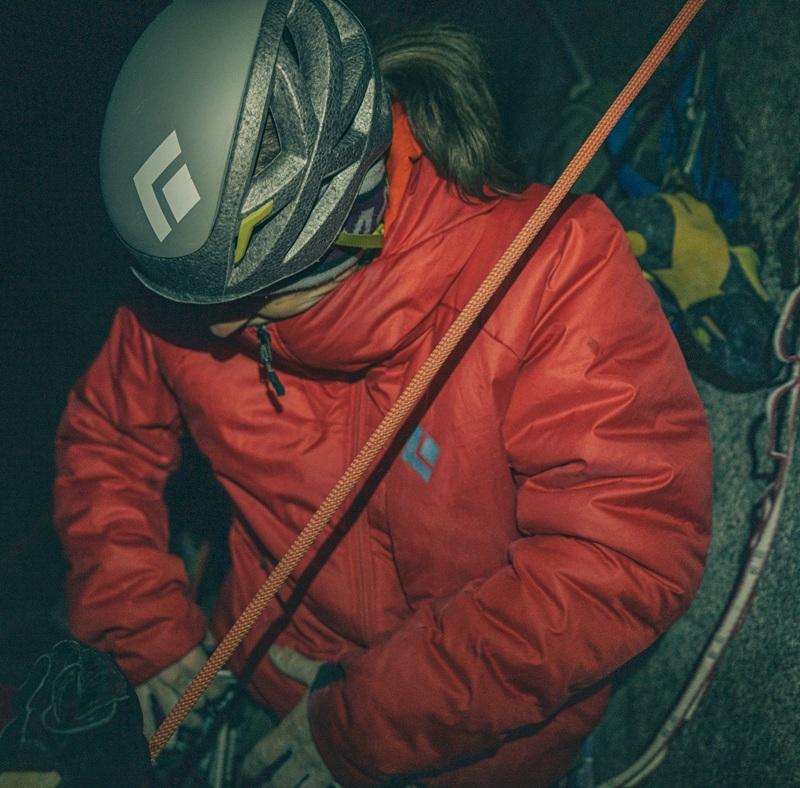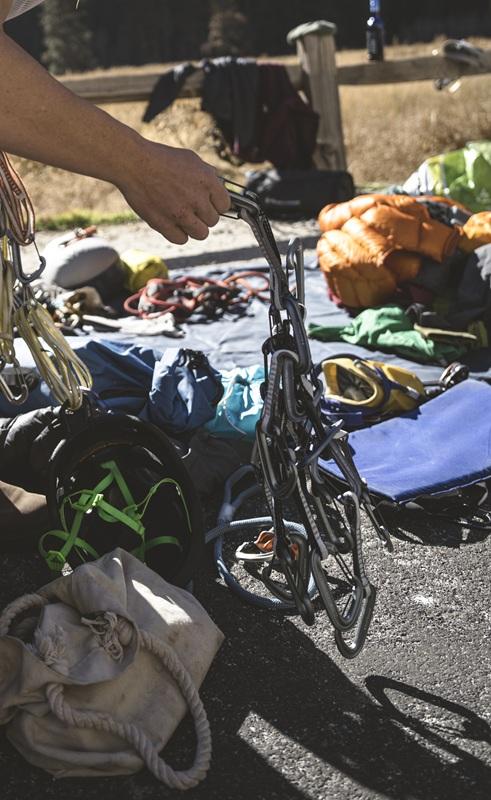In this guide, we review each category of equipment (carabiners, ropes, harnesses, etc.) and detail the following: the applicable standards, the recommended lifespan (for regular use vs storage), the signs of wear or damage to watch out for, the suggested renewal/inspection frequency, and tips on how to check the condition of your gear yourself.
Standards and Markings of PPE
In climbing and mountaineering, safety largely depends on the reliability of your equipment. This is why each piece of personal protective equipment (PPE) must comply with strict safety standards. There are two main standards to be aware of: the European EN standards (mandatory for CE certification in Europe), and the UIAA standards (International Climbing and Mountaineering Federation), which are a voluntary label indicating that the equipment meets the UIAA’s additional criteria. Each item of equipment typically displays markings engraved or printed to indicate these certifications – for example, the EN standard number and the UIAA logo if the item is UIAA certified.
What do these markings mean? A product marked CE followed by a number (e.g. CE0082) means it complies with the European PPE regulation and has been tested by a certified body. The EN reference indicates the specific European standard. For instance, a carabiner will be marked ‘EN 12275’ (the standard for mountaineering carabiners), and will often include the UIAA label if the manufacturer has obtained the relevant certification. The latter guarantees that the product meets the UIAA standards (often equivalent to or stricter than EN standards). The table below summarises the main standards for each type of PPE mentioned:
| Equipment | EN Standard (Europe) | UIAA Standard |
|---|---|---|
| Carabiner | EN 12275 | UIAA 121 |
| Dynamic rope | EN 892 (single, half, or twin rope) | UIAA 101 (dynamic ropes) |
| Harness | EN 12277 (Type C for sit harness) | UIAA 105 |
| Sling (lanyard, loop) | EN 566 | UIAA 104 |
| Quickdraw (sling + carabiners) | EN 12275 + EN 566 | UIAA 121 + 104 |
| Belay device (descender) | EN 15151-1/2 (depending on type) | UIAA 129 |
| Helmet | EN 12492 | UIAA 106 |
| Ice axe | EN 13089 (Type 1 or 2) | UIAA 152 |
| Crampons | EN 893 | UIAA 153 |

Carabiners (connectors)
Applicable standards
Climbing carabiners must comply with:
- EN 12275 standard: defines minimum strength according to axis (e.g. 20 kN major axis, 7 kN minor axis).
- UIAA 121 standard (if UIAA certified).
Recommended lifespan
- No strict expiry date: metal carabiners (aluminium or steel) can last a very long time.
- Indicative lifespan: up to 10 years with moderate use, less if heavily used (falls, salty environments, etc.).
- Essential condition: no signs of wear, well-maintained, no major impacts.
Signs of wear to watch out for
- Mechanical wear: highly localised wear, sharp edges = risk to the rope.
- Faulty gate/spring: gate no longer closes automatically, weak spring, stiff locking mechanism.
- Cracks or deformation: ovalisation, micro-cracks, bent gate? Immediately retire from use.
- Corrosion: rare on anodised aluminium, but possible on steel (deep rust = disqualifying).
- Worn locking mechanism: sleeve loosens on its own, excessive play, damaged threads.
Worth remembering
Any carabiner showing one of these defects must be taken out of service immediately to ensure the user's safety.
Climbing Ropes (Dynamic Ropes)
Applicable standards
Dynamic climbing ropes used for belaying in climbing must comply with:
- EN 892: resistance to standardised falls, maximum elongation, energy absorption.
- UIAA 101 (if UIAA certified): additional certification level.
The EN 892 marking appears on the packaging, and sometimes on a label attached to the end of the rope. The UIAA label is shown if the rope meets its criteria.
Note: only EN 892 ropes are suitable for dynamic belaying. Semi-static ropes (EN 1891) are intended for other uses (caving, difficult access, fixed lines, etc.).
Recommended lifespan
A rope may be stored for up to 5 years in good conditions before its first use, and then used for 5 years in a professional context or up to 10 years for personal use — provided it remains in perfect condition.
Ropes age even without use. Nylon (polyamide) is sensitive to UV rays, moisture, heat, and mechanical shocks.
Signs of wear to watch out for
- Damaged sheath: frayed strands, torn sheath, core visible? Retire immediately.
- Soft spots / localised thinning: indicates internal core rupture.
- Excessive stiffness: loss of elasticity, sign of advanced ageing.
- Severe discolouration: caused by UV exposure or aggressive washing.
- Sheath slippage: sheath sliding over the core? Dangerous misalignment.
- Clean cut: caused by crampons, rocks, or tools? Affected section must be retired.
Worth remembering
A damaged rope must be immediately retired, even if the damage appears localised. If the affected area is within the first few metres, it can be cleanly cut (with a heated, sharp blade). In this case, remember that the rope will be slightly shorter than its original length — important to consider for abseils, for example.
If in doubt, replace it. Safety always comes before cost.
Climbing Harnesses
Applicable standards
Harnesses must comply with:
- EN 12277: climbing and mountaineering harnesses, with different types:
- Type C: adult sit harness (the most common)
- Type B: children’s harness (<40 kg)
- Type A: full-body harness (chest + legs)
- Type D: chest harness
- UIAA 105 (if UIAA certified)
A type C harness must withstand a force of at least 15 kN at the tie-in points.
Harness lifespan
- Total lifespan (storage + use): 5 + 10 years maximum
After a severe fall or intensive use, inspect the harness carefully. If in doubt about its integrity, it’s best to replace it.
Signs of wear to watch out for
- Worn tie-in loops: broken fibres, visible wear indicators (red thread or internal weave showing).
- Damaged stitching: several broken threads on structural seams = danger.
- Clean cuts: any severed strap? The harness must be replaced immediately.
- Discolouration / stiffness: faded or stiff webbing = UV damage? A sign of ageing.
- Deformed metal buckles: cracks, seizing, or faulty mechanisms = take out of service.
- Loose elastic (thigh loops): affects comfort but not direct safety; monitor as a sign of advanced age.
Worth remembering
Plan to replace your harness every 5 years under normal use, and never exceed 10 years even in storage.
Any harness showing critical wear (tie-in points, stitching, buckles) must be immediately retired from use.

Slings, Lanyards and Loops
(Includes sewn slings for climbing: sewn loops, dynamic lanyards, quickdraw slings, etc.)
Applicable standards
Sewn slings used in climbing must comply with:
- EN 566: minimum strength of 22 kN, applicable to loops, sewn lanyards, and quickdraw slings.
- UIAA 104: (if UIAA certified).
Note: Via ferrata lanyards follow different standards (EN 958), and dynamic rope lanyards fall under EN 892. This guide only covers flat or tubular sewn slings made of nylon or Dyneema®.
What is the lifespan of a climbing sling?
- Theoretical maximum lifespan: 10 years (storage + use)
- Typical usage lifespan: 5 years with regular use
- Safety lanyard: recommended replacement every 3 years
Thin Dyneema® slings tend to wear out faster: more frequent replacement is advised depending on usage intensity.
Signs of wear to watch out for
- Cut threads / broken fibres: if more than one third of the sling's width is damaged, retire it immediately.
- Severe abrasion / fuzziness: progressive weakening of the sling’s strength.
- Melted / glazed areas: overheating or rapid friction? Fibres are weakened.
- Discolouration / chemical stains: UV exposure or contact with aggressive substances (acids, fuels)? Hidden danger.
- Damaged stitching: broken or pulled thread at the closure seam = retire as a precaution.
Worth remembering
A sling that feels or looks damaged in any way should no longer be used.
Don’t hesitate to replace it if in doubt: safety is non-negotiable, and the cost of a sling is negligible compared to the risk.

Ice Axes
Applicable standards
Ice axes must comply with:
- EN 13089: standard for ice axes and hand-held anchors, with two types:
- Type 1 (Type B): ‘Basic’ axes with aluminium shaft (glacier hiking, ski mountaineering)
- Type 2 (Type T): ‘Technical’ axes with steel shaft (ice climbing, technical mountaineering)
- UIAA 152 (if UIAA certified)
Markings are essential to determine whether an ice axe can be used as a secure anchor point.
Recommended lifespan
- No specific maximum lifespan, but caution increases with age.
- Shaft and head: may last 10 to 15 years or more with moderate use.
- Pick: wears more quickly; replacement recommended every 1 to 3 years depending on use.
A well-maintained ice axe can last for decades, provided its components — especially the pick — are regularly checked.
Signs of wear to watch out for
- Blunt or cracked pick: rounded teeth, material loss, visible cracks? Replace the pick.
- Play in assembly: pick loose despite tightening? Worn holes or screws? Risk of failure.
- Bent or cracked shaft: any unusual deformation = immediately retire from use.
- Rivets and screws: cracks around rivets, rusty or loose screws? Inspect regularly.
- Worn grip or leash: not critical, but replacement recommended for comfort.
- Rust: light = can be cleaned, deep = potential weakening? Replace the pick.
Worth remembering
Picks are the most exposed components and should be replaced regularly.
The shaft and head can last a very long time but require careful inspection.
Any sign of cracking, unusual play, or a worn pick requires immediate action: partial replacement or retire from use.
Climbing and Mountaineering Helmets
Applicable standards
Helmets must comply with:
- EN 12492: protection against falling objects, multiple impacts (lateral, frontal, rear), and penetration.
- UIAA 106 (if UIAA certified): equivalent to EN 12492 with additional criteria.
Recommended lifespan
- Maximum lifespan: 10 years from the date of manufacture
- Recommended replacement: every 5 years with regular use
- After a major impact: immediate replacement, even if no damage is visible
The internal foam may be compromised without any visible signs. Always replace the helmet after a significant impact.
Signs of wear to watch out for
- Cracks or deformation: on the outer shell or inner foam? Retire the helmet immediately.
- Worn straps / buckles: frayed straps, loose stitching, cracked buckles? Dangerous in the event of a fall.
- Detached internal parts: comfort padding = not critical, but replacement is recommended for optimal fit.
- Faulty adjustment system: broken dial, unstable fit, poor retention? Risk in the event of impact.
- Plastic ageing: dull, brittle, discoloured or cracking shell? Indicates material deterioration.
Worth remembering
A damaged helmet no longer offers effective protection: always replace it if in doubt, after an impact, or if ageing is advanced.
The maximum lifespan is 10 years, but a single impact may require immediate replacement.


Quickdraws
Applicable standards
Quickdraws consist of two separate components, each governed by its own standard:
- Carabiners: EN 12275 and UIAA 121 standards
- Sewn sling: EN 566 and UIAA 104 standards
Check the markings on each component.
The full unit is certified by the manufacturer’s assembly, but the components must be inspected individually.
Recommended lifespan
- Carabiners: long lifespan (potentially 10+ years) if properly maintained
- Sling: under intensive use, replacement is recommended every 2 to 5 years, with a theoretical maximum of 10 years
It is common to replace the sling to extend the life of the quickdraw.
However, if the carabiners show signs of fatigue (soft spring, worn edges...), replace the entire quickdraw.
Signs of wear to watch out for
- Anchor-side carabiner: grooves, worn nose or gate? Retire if wear is advanced.
- Rope-side carabiner: rope friction zone worn? Watch out for sharp edges. Also check the string (rubber keeper), which must hold the carabiner securely in place.
- Sling: inspect the ends, areas beneath the string, and stitching.
Warning signs: cut threads, melted patches, sheared sections, or localised wear.
A misaligned carabiner or twisted sling can compromise the correct function of the quickdraw.
Worth remembering
A quickdraw must be retired if even one of its components is defective.
The system is only as reliable as its weakest element.
Don’t hesitate to replace it if you spot a fault, whether on the sling or on either carabiner.
Belay Devices and Descenders
Applicable standards
Belay devices are governed by:
- EN 15151-1: devices with braking assistance (auto-locking or mechanical belay devices)
- EN 15151-2: devices without assistance (tube-style, figure-eight, etc.)
- UIAA: some models may also be UIAA certified
Recommended lifespan
- No strict maximum lifespan: depends entirely on wear
- With moderate use: up to 10 years or more
- With intensive use: only a few years
Metal components are durable, but mechanical wear (grooves, cam, friction) can require replacing a belay device well before the 10-year mark.
Specific cases:
- Cam-based devices: moving parts are more vulnerable to wear (spring, cam surface)
- Plastic components: ageing is similar to that of helmets — replace if cracked
Signs of wear to watch out for
- Worn grooves (tube, figure-eight): sharp edges, thinned metal = rope damage risk? Retire the device
- Visible deformation: even slight = end of service life
- Cracks / fractures: around holes, levers, or the body? Immediate retirement required
- Worn cam or weak spring: reduced braking, slow or no lever return? Replacement advised
- Axles or rivets: excessive play = structural wear
- Cracked plastic parts: risk of breakage? Retire immediately
- Embedded dirt: may block mechanisms? Thorough cleaning essential
- Excessive heat (descenders): burn marks or discolouration = possible surface damage? Monitor closely
Worth remembering
A belay device must be replaced as soon as any component shows a critical fault, even if it still works.
Reliability depends on the integrity of the braking mechanism: any wear affecting this central function demands careful inspection — and likely replacement.
Crampons
Applicable standards
Mountaineering crampons are subject to:
- EN 893: standard covering tensile strength, rigidity, and deformation of the points.
- UIAA 153: complementary UIAA standard
The standard applies to the metallic part of the crampon, regardless of the binding system (strap-on, hybrid, or automatic).
Recommended lifespan
- No specific maximum lifespan: metal crampons can last a very long time if properly maintained.
- Limiting factors: worn points, corrosion, mechanical play, structural cracks.
Steel technical crampons are more durable, but aluminium crampons (used in ski mountaineering) wear out more quickly, especially on mixed or rocky terrain.
Signs of wear to watch out for
- Shortened or thinned points: if the front points have lost more than 50% of their length or are overly tapered? Replacement recommended.
- Play in joints: in articulated or modular crampons, excessive play in rivets or screws = structural wear? Tighten or replace the components.
- Deformed or cracked linking bar: must be replaced immediately if cracked, especially near the adjustment holes.
- Binding system:
- Metal toe bail: check it isn’t bent or cracked.
- Plastic parts (heel lever, buckles, toe bail): monitor for cracks, wear, or excessive play.
- Straps: check for cuts or localised wear near buckles — replace if in doubt.
- Damaged anti-balling plates: cracks, delamination, or reduced effectiveness? Plan for replacement.
- Corrosion: light = can be cleaned; deep = metal weakening? Retire the crampon from use.
Worth remembering
Crampons may appear solid at first glance but can have critical faults in the points, bindings, or joints.
They must be inspected regularly, and any part showing signs of weakness should be replaced.
Safety relies on the full mechanical integrity of the equipment.
Summary
To put it simply: textile parts or equipment have a maximum lifespan of 5 + 10 years (storage + use). For metal equipment, the lifespan can be unlimited. After a significant fall, equipment must be replaced — just as it should be when wear becomes considerable.
Safety in climbing and mountaineering relies on thorough knowledge and maintenance of your gear. Each item of PPE is governed by specific standards (EN/UIAA), which guarantee an initial level of strength, but it is up to you to maintain that reliability over time by monitoring wear, respecting recommended service life, and performing regular inspections. Never hesitate to retire questionable equipment — gear can be replaced; a life or physical wellbeing cannot. Finally, always follow the manufacturer’s advice, keep your instruction manuals, and if in doubt, consult a professional (guide or instructor) who can provide informed guidance.
By taking care of your safety equipment (carabiners, ropes, harnesses, helmets, etc.), you can climb with peace of mind — focused on the mountains, not your gear. Enjoy your climb safely!
